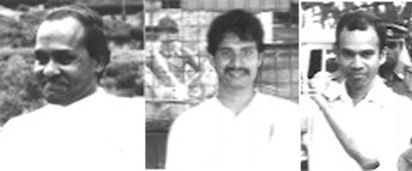On the 25th July 1983 Sellarasa “Kuttimani” Yogachandiran, leader of the Tamil Eelam Liberation Organisation (TELO) and Ganeshanathan Jeganathan, a political writer, had their eyes gouged out in mockery before being killed by Sinhalese inmates at the high security Welikada prison in Colombo. A total of 37 Tamil prisoners were murdered the same day, and 18 more were killed two days later.
5th August 1983 – The Guardian, UK
The International Commission of Jurists commented:
More information on Sangam.org.
 |
| Tamil political prisoners: Dr S Rajasunderam, Selvarajah Yogandram and Nadarajah Thangathurai |
5th August 1983 – The Guardian, UK
'It is the massacres in the Welikade gaol which are attracting the most attention. There is a particular interest in circumstances in which two alleged guerrilla leaders were killed.
The two men, Sellarasa “Kuttimani” Yogachandiran, leader of the Tamil Eelam Liberation Organization (TELO) and a political writer, and Ganeshanathan Jeganathan had been sentenced to death last year for the murder of a policeman.
In speeches from the dock, the two men had announced that they would donate their eyes in the hope that they would be grafted on to Tamils who would see the birth of Eelam, the independent state they were fighting for.
Second hand reports from Batticaloa gaol, where the survivors of the Welikada massacre are now being kept, say that the two men were forced to kneel and their eyes gouged out with iron bars before they were killed.
One version has it that Kuttimani’s tongue was cut out by an attacker who drank the blood and cried: “I have drunk the blood of a Tiger.”
The two men were among the 35 Tamils killed in the Welikada gaol on July 25. Another 17 were killed in the gaol two days later and the Guardian has obtained a first hand account of part of the fighting in this incident, including the circumstances in which Sri Lanka’s Gandhian leader, Dr. Rajasunderam, died.
Dr. Rajasunderam was one of nine men, including two Catholic priests and a Methodist minister, who were moved out of their cells immediately after the July 25 killings—to make way for survivors moved into their cells on security grounds—into a padlocked hall, upstairs in the same block.
The nine, convinced that further attacks were coming, made repeated representations to the prison authorities on July 26 for better security measures. Assurances were given that they would be protected, but nothing was done.
At 2:30 pm in July 27, hearing screaming and whistling outside, one of the priests looked out of a high window and saw prisoners breaking in from a neighboring compound, wielding axes, iron bars, pieces of firewood, and sticks. There was no sign of the prison guards.
The mob, which was later found to have killed 16 prisoners in the downstairs cells, ran up to the hall and began breaking the padlock. Dr. Rajasunderam then went to the door and cried out: “Why are you trying to kill us? What have we done to you?” At that moment, the door burst open and Dr. Rajasunderam was hit on the side of the neck by a length of iron. Blood was seen to spurt several feet.
“At that juncture, we thought we should defend ourselves,” one of the prisoners related. “We broke the two tables in the hall and took the legs to defend ourselves.” “We kept them at bay. They threw bricks at us. We threw them back. Pieces of firewood and an iron bar were thrown at us. We used them to defend ourselves. It went on for about half an hour. They shouted: ‘You are the priests, we must kill you.’”
The killing was eventually ended by the army, who moved in with teargas. An inquest has been opened into the Welikada massacres, but the above details did not emerge. Prison warders claim that keys to the cells were stolen from them.
Lawyers for the prisoners who have accused the warders of having participated, claim that they were not given the opportunity to bring evidence despite representation to the Government.'
The International Commission of Jurists commented:
"It is not clear how it was possible for the killings to take place without the connivance of prison officials, and how the assassinations could have been repeated after an interval of two days, since Welikade prison is a high security prison and the Tamil prisoners were kept in separate cells..."(Ethnic Violence in Sri Lanka, 1981-83: Staff Report of the International Commission of Jurists, ICJ Review)
More information on Sangam.org.
